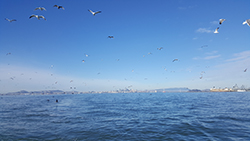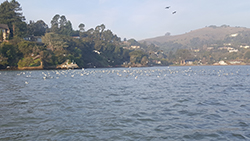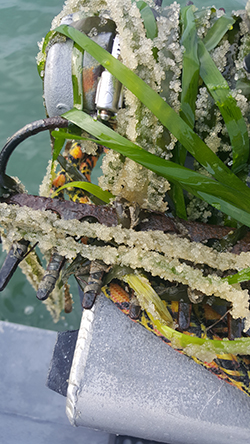
Circling birds indicate an offshore herring spawning event near Alameda.

Bird activity after a spawning event.

Heavy spawn on eelgrass.
On a drizzly winter day in San Francisco Bay, you might find CDFW Environmental Scientist Ryan Bartling surveying the shoreline on the research vessel Smoothhound in search of Pacific Herring (Clupea pallasii) eggs. Bartling is one member of a team of state biologists who monitor the San Francisco Bay Herring fishery in the winter months, counting eggs and using those numbers to estimate the size of the Herring population that enters the Bay each season. CDFW Environmental Scientists Tom Greiner and Andrew Weltz are the other members of the Herring Team who lead the collection of biological data and management of commercial take of Herring in San Francisco Bay.
“We see, on average, about 50,000 tons of Herring come into San Francisco Bay during the spawn events that occur about 12 times each year,” Bartling explains. “The fish typically show up from November through March, so that’s when we’re out there counting eggs and collecting biological information on adult Herring.”
Even before the spawning season starts, Bartling and Weltz, with assistance from other CDFW divers, perform SCUBA surveys in the Bay to estimate how much vegetation is present. In-season, Greiner runs weekly trawl surveys, using the 28-foot research vessel Triakis to catch adult Herring before they spawn. This catch provides information on size, weight and age of the adult herring, it also provides information on general health and condition.
Once the spawning begins, the biologists concentrate on spawn deposition surveys – which involves finding and counting egg masses wherever the fish lay them. Eelgrass (Zostera marina) and red algae (Gracilaria species) are common vegetation types for spawning Herring, but the fish will also gravitate to hard surfaces or man-made structures near the shoreline – pier pilings, boat bottoms and even submerged shopping carts, anything in the vicinity of a spawn is fair game. Although the eggs are tiny (about the size of the tip of a pencil), they’re laid in mass.
How do the biologists know where to look? There’s a dead giveaway. “The key indicators are the birds and marine mammals – they always find them first!” Bartling says. Using the circling birds as his guide, Bartling walks along the shoreline at low tide to do a visual count of eggs, or, if aboard the Smoothhound, he uses a rake to pull up vegetation from below.
When a spawning event is occurring, the actual survey time varies. CDFW scientists could be counting eggs for as little as four hours, or as long as 12 hours at a time depending on the size of the Herring school. Using the egg count numbers (which are typically in the billions or trillions), they can calculate estimates of Herring tonnage. “An estimate could be as small as one ton of Herring per spawn event up, or might be as high as 15,000 tons,” Bartling says. “It depends on time of year and the overall stock size.”
The estimates are necessary for CDFW to set quotas for California’s commercial Herring fishery, which runs from January through mid-March. Quotas are typically set at around 5 percent of the total tonnage the biologists calculated from the previous season.
CDFW Herring fishery management staff maintain a blog,  CDFW Pacific Herring Management News, to keep the public apprised of the health and status of the fishery. More information about the commercial Pacific Herring fishery can be found on CDFW’s website.
CDFW Pacific Herring Management News, to keep the public apprised of the health and status of the fishery. More information about the commercial Pacific Herring fishery can be found on CDFW’s website.
CDFW Photos. Top Photo: CDFW Environmental Scientist Ryan Bartling looks at herring eggs after a spawning event.
###
Media Contact:
Kirsten Macintyre, CDFW Communications, (916) 322-8988